Висячие сады семирамиды на английском языке доклад
Обновлено: 14.05.2024
Вопрос по английскому языку:
Люди помогите! Висячие Сады Семирамиды полный доклад на Английском.
Трудности с пониманием предмета? Готовишься к экзаменам, ОГЭ или ЕГЭ?
Воспользуйся формой подбора репетитора и занимайся онлайн. Пробный урок - бесплатно!
- 08.11.2017 00:36
- Английский язык
- remove_red_eye 6327
- thumb_up 32
Ответы и объяснения 1
he Hanging Gardens of Babylon were considered to be one of the Seven Wonders of the Ancient World, and the only one of the Wonders that may have been purely legendary. They were purportedly built in the ancient city-state of Babylon, near present-day Al Hillah, Babil province, in Iraq. The Hanging Gardens were not the only World Wonder in Babylon; the city walls and obelisk attributed to Queen Semiramis were also featured in ancient lists of Wonders.[1]
The gardens were attributed to the Neo-Babylonian king Nebuchadnezzar II, who ruled between 605 and 562 BC. He is reported to have constructed the gardens to please his homesick wife, Amytis of Media, who longed for the plants of her homeland.[2] The gardens were said to have been destroyed by several earthquakes after the 2nd century BC.[citation needed]
The Hanging Gardens of Babylon are documented by ancient Greek and Romans writers, including Strabo, Diodorus Siculus, and Quintus Curtius Rufus. However, no cuneiform texts describing the Hanging Gardens are extant, and no definitive archaeological evidence concerning their whereabouts have been found.[3][4]
Ancient writers describe the possible use of something similar to an Archimedes screw as a process of irrigating the terraced gardens.[5] Estimates based on descriptions of the gardens in ancient sources say the Hanging Gardens would have required a minimum amount of 8,200 gallons of water per day.[6]Nebuchadnezzar II is also reported to have used massive slabs of stone, a technique not otherwise attested in Babylon, to prevent the water from eroding the ground
Дорогой ученик! В этом материале опубликованы чудеса света на английском языке. Под английским текстом есть перевод на русский язык.
The Great Pyramid of Giza
The Great Pyramid of Giza (also known as the Pyramid of Khufu or the Pyramid of Cheops) is the largest of the three pyramids in the Giza pyramid complex.
It is the oldest of the Seven Wonders of the Ancient World, and the only one to remain largely intact.
The Colossus of Rhodes
The Colossus of Rhodes was a statue of the Greek sun-god Helios, erected in the city of Rhodes, on the island of Rhodes, by Chares of Lindos.
The Lighthouse of Alexandria
The Lighthouse of Alexandria, sometimes called the Pharos of Alexandria, was a lighthouse built during the reign of Ptolemy II Philadelphus.
It was constructed in the 3rd century BC on the island of Pharos. For many centuries it was one of the tallest man-made structures in the world.
The Mausoleum at Halicarnassus
The Mausoleum at Halicarnassus (Bodrum, Turkey), was a massive tomb built in the 4th century BC for Mausolus, the ruler of Caria.
Following a damaging earthquake, and with many elements cannibalised for the 15th century CE Bodrum Castle, the Mausoleum no longer survives.
The Temple of Artemis
Temple of Artemis was a Greek temple at Ephesus (present Turkey). The great temple was built by Croesus, king of Lydia, in the 6th century BC and was rebuilt after being burned by a madman named Herostratus in 356 BCE.
The Statue of Zeus at Olympia
The statue was created by the Greek sculptor Phidias in the 5th century BC. It was placed in the huge Temple of Zeus at Olympia.
The statue, almost 12 m high and plated with gold and ivory, represented the god sitting on a throne ornamented with ebony, ivory, gold, and precious stones.
The Hanging Gardens of Babylon
According to legend, the Hanging Gardens were built by the Neo-Babylonian King Nebuchadnezzar II (who ruled between 605 and 562 BC), for his Median wife Queen Amytis, because she missed the green hills and valleys of her homeland.
The construction of the Hanging Gardens has also been attributed to the legendary queen Semiramis, who supposedly ruled Babylon in the 9th century BC, and they have been called the Hanging Gardens of Semiramis as an alternate name.
- Для учеников 1-11 классов и дошкольников
- Бесплатные сертификаты учителям и участникам

Описание презентации по отдельным слайдам:


СОДЕРЖАНИЕ (Список рассматриваемых вопросов) Введение (кратко обосновывается актуальность выбранной темы, цель и содержание поставленных задач, дается характеристика работы…) Основная часть состоит из двух разделов: Теоретического и практического (или исследовательского). Теоретический раздел включает анализ информации, отбор наиболее значимых данных, выстраивание общей логической схемы выводов. Практический раздел (исследовательский) – описание изготовления проектируемого изделия или собственное исследование, сравнение и анализ. Заключение содержит основные выводы. Это вывод о проделанной работе, описание полученных результатов.

I Seven Quick Facts Location: City State of Babylon (Modern Iraq) Built: Around 600 BC Function: Royal Gardens Destroyed: Earthquake, 2nd Century BC Size: Height probably 80 ft. (24m) Made of: Mud brick waterproofed with lead. Other: Some archeologists suggest that the actual location was not in Babylon, but 350 miles to the north in the city of Nineveh.

The city of Babylon, under King Nebuchadnezzar II, must have been a wonder to the ancient traveler's eyes. "In addition to its size," wrote Herodotus, a Greek historian in 450 BC, "Babylon surpasses in splendor any city in the known world." Herodotus claimed the outer walls were 56 miles in length, 80 feet thick and 320 feet high. Wide enough, he said, to allow two four-horse chariots to pass each other. The city also had inner walls which were "not so thick as the first, but hardly less strong." Inside these double walls were fortresses and temples containing immense statues of solid gold. Rising above the city was the famous Tower of Babel, a temple to the god Marduk, that seemed to reach to the heavens.
While archaeological excavations have disputed some of Herodotus's claims (the outer walls seem to be only 10 miles long and not nearly as high) his narrative does give us a sense of how awesome the features of the city appeared to those ancients that visited it. Strangely, however, one of the city's most spectacular sites is not even mentioned by Herodotus: The Hanging Gardens of Babylon, one of the Seven Wonders of the Ancient World.

Gift for A Homesick Wife Accounts indicate that the garden was built by King Nebuchadnezzar, who ruled the city for 43 years starting in 605 BC (There is an alternative story that the gardens were built by the Assyrian Queen Semiramis during her five year reign starting in 810 BC). This was the height of the city's power and influence and King Nebuchadnezzar is known to have constructed an astonishing array of temples, streets, palaces and walls. According to accounts, the gardens were built to cheer up Nebuchadnezzar's homesick wife, Amyitis. Amyitis, daughter of the king of the Medes, was married to Nebuchadnezzar to create an alliance between the two nations. The land she came from, though, was green, rugged and mountainous, and she found the flat, sun-baked terrain of Mesopotamia depressing. The king decided to relieve her depression by recreating her homeland through the building of an artificial mountain with rooftop gardens. II

The Hanging Gardens probably did not really "hang" in the sense of being suspended from cables or ropes. The name comes from an inexact translation of the Greek word kremastos, or the Latin word pensilis, which means not just "hanging", but "overhanging" as in the case of a terrace or balcony. The Greek geographer Strabo, who described the gardens in first century BC, wrote, "It consists of vaulted terraces raised one above another, and resting upon cube-shaped pillars. These are hollow and filled with earth to allow trees of the largest size to be planted. The pillars, the vaults, and terraces are constructed of baked brick and asphalt." "The ascent to the highest story is by stairs, and at their side are water engines, by means of which persons, appointed expressly for the purpose, are continually employed in raising water from the Euphrates into the garden."
Garden Construction Construction of the garden wasn't only complicated by getting the water up to the top, but also by having to avoid having the liquid ruining the foundations once it was released. Since stone was difficult to get on the Mesopotamian plain, most of the architecture in Babel utilized brick. The bricks were composed of clay mixed with chopped straw and baked in the sun. These were then joined with bitumen, a slimy substance, which acted as a mortar. Unfortunately, because of the materials they were made of, the bricks quickly dissolved when soaked with water. For most buildings in Babel this wasn't a problem because rain was so rare. However, the gardens were continually exposed to irrigation and the foundation had to be protected.

Diodorus Siculus, a Greek historian, stated that the platforms on which the garden stood consisted of huge slabs of stone (otherwise unheard of in Babel), covered with layers of reed, asphalt and tiles. Over this was put "a covering with sheets of lead, that the wet which drenched through the earth might not rot the foundation. Upon all these was laid earth of a convenient depth, sufficient for the growth of the greatest trees. When the soil was laid even and smooth, it was planted with all sorts of trees, which both for greatness and beauty might delight the spectators.“ How big were the gardens? Diodorus tells us they were about 400 feet wide by 400 feet long and more than 80 feet high. Other accounts indicate the height was equal to the outer city walls, walls that Herodotus said were 320 feet high. In any case the gardens were an amazing sight: A green, leafy, artificial mountain rising off the plain.

Were the Hanging Gardens Actually in Nineveh? But did they actually exist? Some historians argue that the gardens were only a fictional creation because they do not appear in a list of Babylonian monuments composed during that period. It is also a possibility they were mixed up with another set of gardens built by King Sennacherib in the city of Nineveh around 700 B.C.. III

Stephanie Dalley, an Oxford University Assyriologist, thinks that earlier sources were translated incorrectly putting the gardens about 350 miles south of their actual location at Nineveh. King Sennacherib left a number of records describing a luxurious set of gardens he'd built there in conjunction with an extensive irrigation system. In contrast Nebuchadrezzar makes no mention of gardens in his list of accomplishments at Babylon. Dalley also argues that the name "Babylon" which means "Gate of the Gods" was a title that could be applied to several Mesopotamian cities. Sennacherib apparently renamed his city gates after gods suggesting that he wished Nineveh to be considered "a Babylon" too, creating confusion.

Is it possible that Greek scholars who wrote the accounts about the Babylon site several centuries later confused these two different locations? If the gardens really were in Babylon, can the remains be found to prove their existence? While excavating the Southern Citadel, Koldewey, German archaeologist, discovered a basement with fourteen large rooms with stone arch ceilings. Ancient records indicated that only two locations in the city had made use of stone, the north wall of the Northern Citadel, and the Hanging Gardens. The north wall of the Northern Citadel had already been found and had, indeed, contained stone. This made Koldewey think that he had found the cellar of the gardens.
While Koldewey was convinced he'd found the gardens, some modern archaeologists call his discovery into question, arguing that this location is too far from the river to have been irrigated with the amount of water that would have been required. Also, tablets recently found at the site suggest that the location was used for administrative and storage purposes, not as a pleasure garden. He continued exploring the area and discovered many of the features reported by Diodorus. Finally, a room was unearthed with three large, strange holes in the floor. Koldewey concluded this had been the location of the chain pumps that raised the water to the garden's roof.

Описание презентации Висячие сады Семирамиды ВЫПОЛНИЛА СТУДЕНТКА 1 КУРСА МИЭ по слайдам

Висячие сады Семирамиды ВЫПОЛНИЛА СТУДЕНТКА 1 КУРСА МИЭ ЭП ЩЁКОТОВА ВАЛЕРИЯ
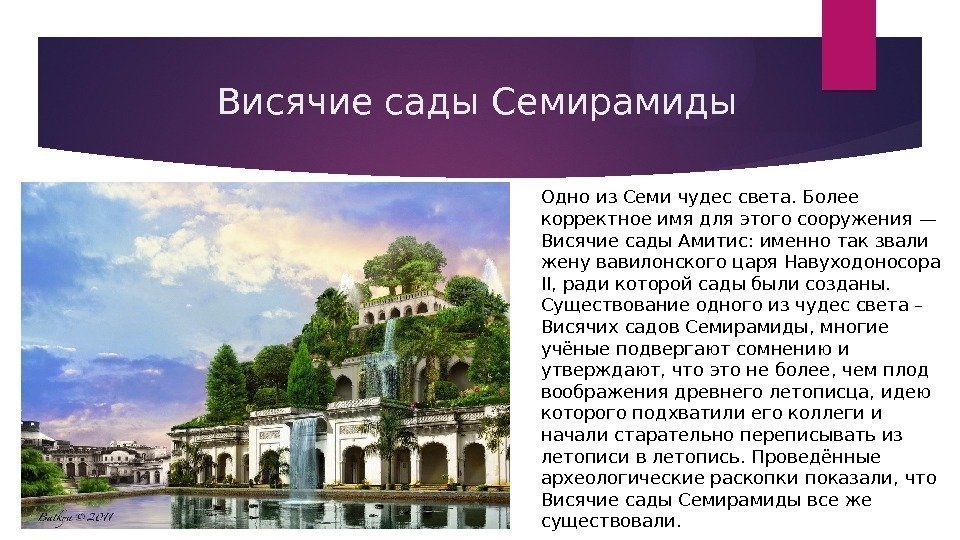
Висячие сады Семирамиды Одно из Семи чудес света. Более корректное имя для этого сооружения — Висячие сады Амитис: именно так звали жену вавилонского царя Навуходоносора II, ради которой сады были созданы. Существование одного из чудес света – Висячих садов Семирамиды, многие учёные подвергают сомнению и утверждают, что это не более, чем плод воображения древнего летописца, идею которого подхватили его коллеги и начали старательно переписывать из летописи в летопись. Проведённые археологические раскопки показали, что Висячие сады Семирамиды все же существовали.
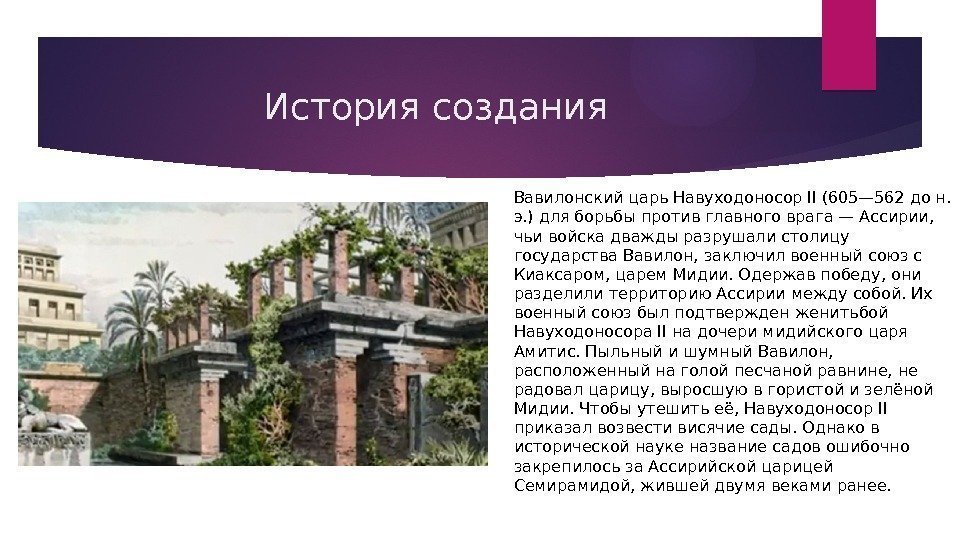
История создания Вавилонский царь Навуходоносор II (605— 562 до н. э. ) для борьбы против главного врага — Ассирии, чьи войска дважды разрушали столицу государства Вавилон, заключил военный союз с Киаксаром, царем Мидии. Одержав победу, они разделили территорию Ассирии между собой. Их военный союз был подтвержден женитьбой Навуходоносора II на дочери мидийского царя Амитис. Пыльный и шумный Вавилон, расположенный на голой песчаной равнине, не радовал царицу, выросшую в гористой и зелёной Мидии. Чтобы утешить её, Навуходоносор II приказал возвести висячие сады. Однако в исторической науке название садов ошибочно закрепилось за Ассирийской царицей Семирамидой, жившей двумя веками ранее.
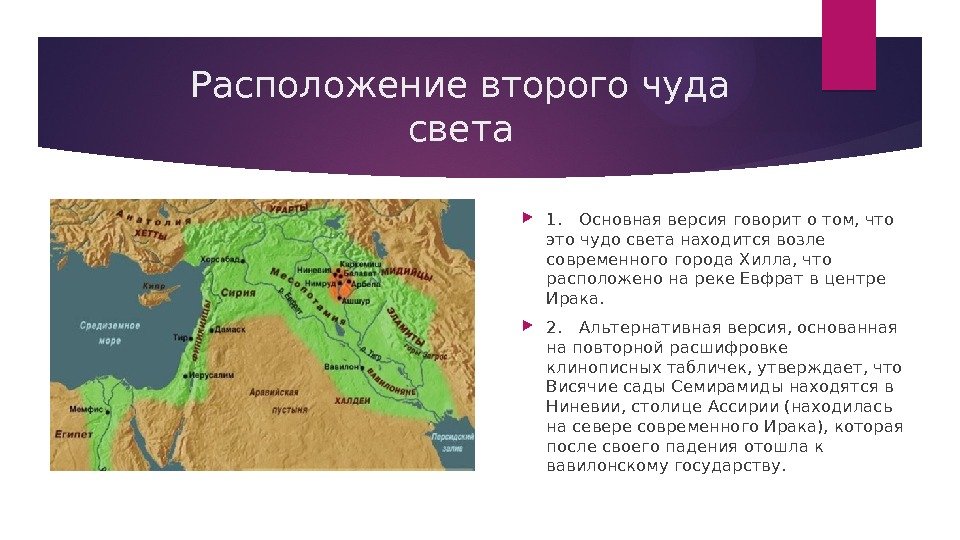
Расположение второго чуда света 1. Основная версия говорит о том, что это чудо света находится возле современного города Хилла, что расположено на реке Евфрат в центре Ирака. 2. Альтернативная версия, основанная на повторной расшифровке клинописных табличек, утверждает, что Висячие сады Семирамиды находятся в Ниневии, столице Ассирии (находилась на севере современного Ирака), которая после своего падения отошла к вавилонскому государству.
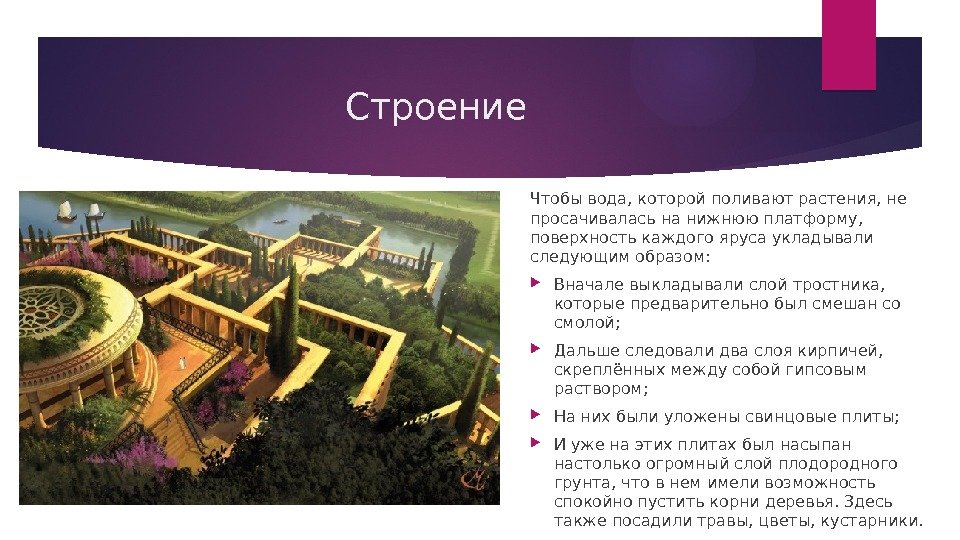
Строение Чтобы вода, которой поливают растения, не просачивалась на нижнюю платформу, поверхность каждого яруса укладывали следующим образом: Вначале выкладывали слой тростника, которые предварительно был смешан со смолой; Дальше следовали два слоя кирпичей, скреплённых между собой гипсовым раствором; На них были уложены свинцовые плиты; И уже на этих плитах был насыпан настолько огромный слой плодородного грунта, что в нем имели возможность спокойно пустить корни деревья. Здесь также посадили травы, цветы, кустарники.
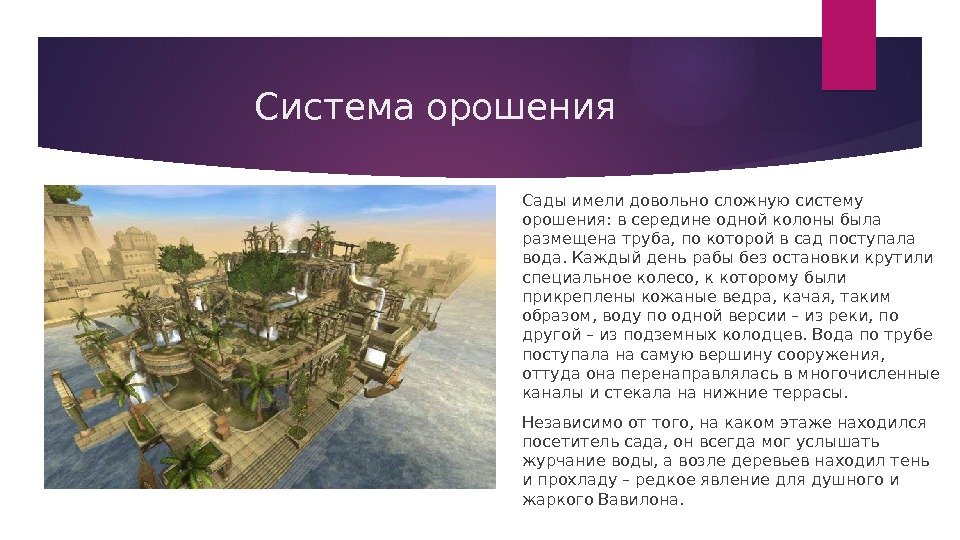
Система орошения Сады имели довольно сложную систему орошения: в середине одной колоны была размещена труба, по которой в сад поступала вода. Каждый день рабы без остановки крутили специальное колесо, к которому были прикреплены кожаные ведра, качая, таким образом, воду по одной версии – из реки, по другой – из подземных колодцев. Вода по трубе поступала на самую вершину сооружения, оттуда она перенаправлялась в многочисленные каналы и стекала на нижние террасы. Независимо от того, на каком этаже находился посетитель сада, он всегда мог услышать журчание воды, а возле деревьев находил тень и прохладу – редкое явление для душного и жаркого Вавилона.
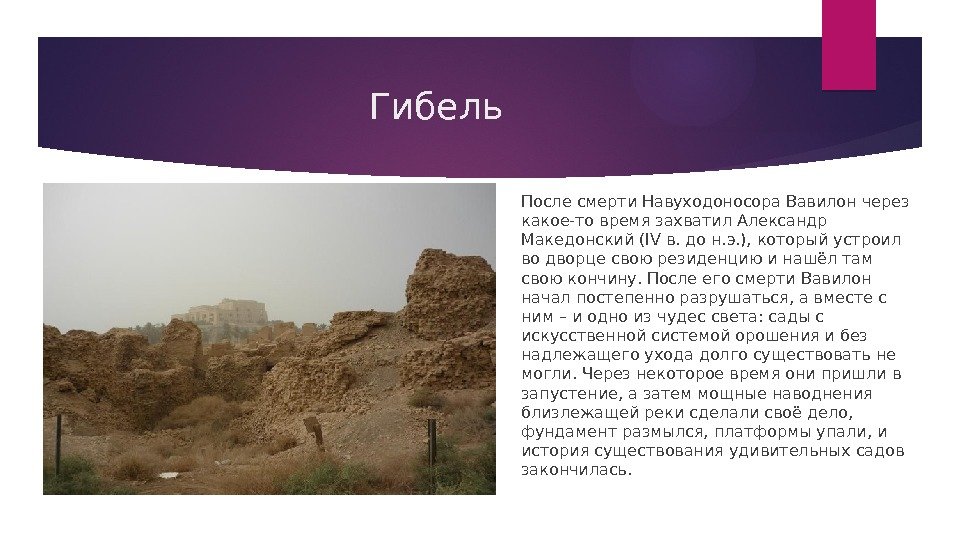
Гибель После смерти Навуходоносора Вавилон через какое-то время захватил Александр Македонский (IV в. до н. э. ), который устроил во дворце свою резиденцию и нашёл там свою кончину. После его смерти Вавилон начал постепенно разрушаться, а вместе с ним – и одно из чудес света: сады с искусственной системой орошения и без надлежащего ухода долго существовать не могли. Через некоторое время они пришли в запустение, а затем мощные наводнения близлежащей реки сделали своё дело, фундамент размылся, платформы упали, и история существования удивительных садов закончилась.

Спасибо за внимание!
Читайте также:

